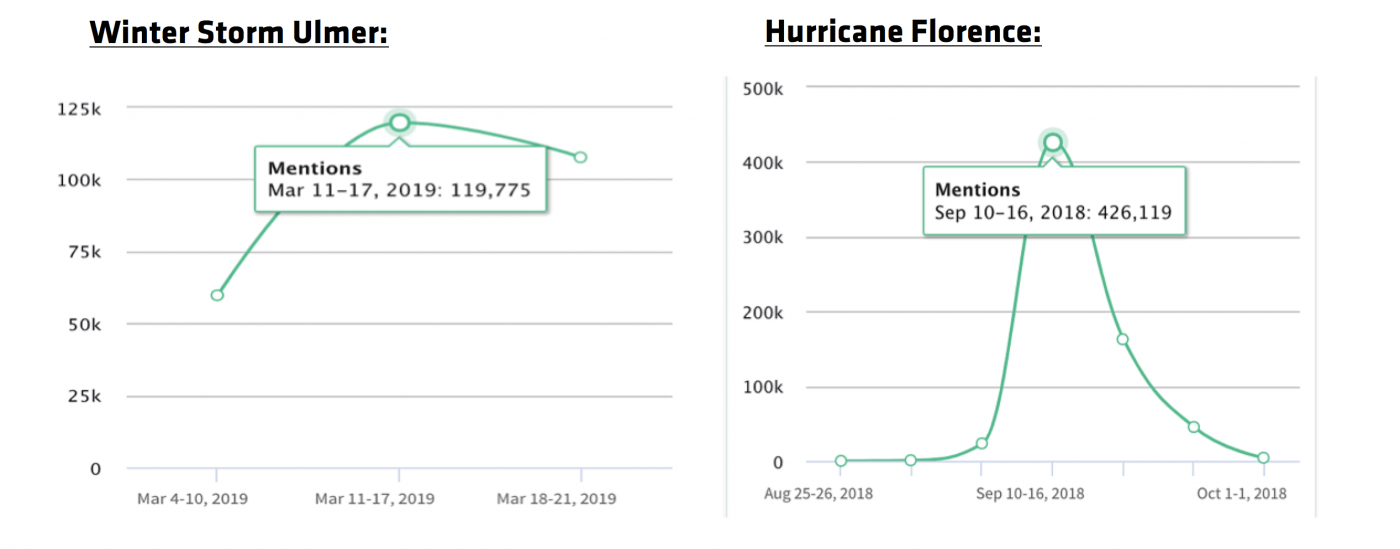On March 13, 2019, Winter Storm Ulmer began to move from the Rockies across the Midwest – delivering severe winds, blizzard conditions, and heavy rainfall across a significant portion of the United States and leading to historic flooding, emergency declarations, and evacuations. However, this storm and its devastating impacts did not receive a very high amount of attention beyond the local media level over the past week.
According to data from TrendKite, Winter Storm Ulmer (at its peak week of coverage) received approximately one-third the amount of total media coverage that Hurricane Florence received and one half the amount of media coverage that Hurricane Michael received.

As a disaster response organization, monitoring storms, their impact, and the media surrounding them is a very important part of what we do. We’ve consistently noticed a disparity in media coverage when it comes to American “Heartland” disasters vs. disasters affecting coastal, urban, and more densely populated areas. A recent Forbes article provides some insight as to why this may happen.
In the article, Forbes Tompkins, Officer of Flood-Prepared Communities at The Pew Charitable Trusts asserts:
“Unfortunately, late and limited coverage seems to be a common theme for inland flooding. Coastal flooding driven by hurricanes tends to grab headlines but some might be surprised to know that over the last 10 years, six out of the eight states experiencing the most major floods have been inland. Further, how many people outside of Nebraska would know this latest flood is the 14th such disaster to strike the state since 2008 – 5th most of any state in the nation.”
Mike Chesterfield, Director of Weather Presentation at The Weather Channel added:
“Partly due to the fact that the forecast called for rainfall totals that were not earth shattering some were slow to realize the top end potential of this event thus many in the media were not prepared for the level of flooding that did occur which meant there was not a ton of run-up to this particular event. As a result the news media really did not have this event on their radar until late in the game….”
Chesterfield also highlighted that because this particular event did not strike a heavily populated area, there was likely less attention being paid to it.
“There is no doubt news executives are under more pressure than ever to get ratings up. Like it or not, the news has become a billion dollar business. This has an impact on which stories news organizations decide warrant their resources. The fact is that it is much easier to craft and sell a story that impacts everyone as opposed to a story that severely impacted an area that contains a relatively small population.”
While the devastating floods impacting the Midwest may not be getting the media attention they deserve, these American Heartland communities still need help nonetheless.
At Team Rubicon, we have a bias for action and cannot stand idly by when communities – large or small, urban or rural – are suffering in the wake of a disaster. So, we’re in the process of launching a series of flood response and recovery operations in states across the Midwest. Operations are currently running in South Dakota and Wisconsin. We’re mobilizing teams to deploy to Nebraska. And, we’re continuing to monitor and identify communities that need assistance in Illinois, Iowa, and Missouri. Stay tuned for more updates.



